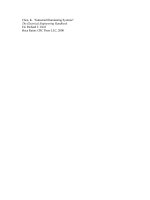Lecture Electrical Engineering: Lecture 25 - Dr. Nasim Zafar
Bạn đang xem bản rút gọn của tài liệu. Xem và tải ngay bản đầy đủ của tài liệu tại đây (788.78 KB, 43 trang )
COMSATS Institute of Information Technology
Virtual campus
Islamabad
Dr. Nasim Zafar
Electronics 1 EEE 231
Fall Semester – 2012
Basic SingleStage BJT Amplifiers
Lecture No.
25
Ø
Contents:
Nasim Zafar
2
Lecture No. 25
Reference:
SingleStage BJT Amplifier
Chapter5.7
Microelectronic Circuits
Adel S. Sedra and Kenneth C. Smith.
Nasim Zafar
3
Introduction
Ø
Ø
Ø
The largesignal operation of the BJT amplifier, discussed in
lecture 20 (Section 5.3), identifies the region over which a
properly biased transistor can be operated as a linear amplifier
for small signals.
Methods for dc biasing the BJT were studied in lecture 22
(Section 5.5), and a detailed study of the smallsignal
amplifier operation was also presented (Section 5.6).
We are now ready to consider practical transistor amplifiers,
and we will do so in this lecture for circuits suitable for
Nasim Zafar
4
discretecircuit fabrication.
Introduction (contd.)
Ø
There are basically three configurations for implementing
singlestage BJT amplifiers:
Ø
v
The commonemitter
v
The commonbase and
v
The commoncollector configurations
All three will be discussed in this lecture, using the same basic
structure, with the same biasing arrangements.
Nasim Zafar
5
Introduction (contd.)
Ø
Ø
Ø
The basic circuit that we shall use, to implement the various
configurations of BJT amplifiers, is shown in slide 8, Ref.
SedraSmith (Figure 5.59).
Among the various biasing schemes possible for discrete BJT
amplifiers, we have selected for simplicity and effectiveness,
the one employing constantcurrent biasing (Section 5.5).
Slide 8 indicates the dc currents in all branches and the dc
voltages at all nodes.
Nasim Zafar
6
Introduction (contd.)
Ø
Ø
Ø
We would want to select a large value for RB in order to keep
the input resistance at the base large (slide 8).
However, we also want to limit the dc voltage drop across RB
and the variability of this dc voltage, resulting from the
variation in β values.
The dc voltage VB determines the allowable signal swing at
the collector.
Nasim Zafar
7
The Basic Structure
Basic structure of the circuit used to realize singlestage,
discretecircuit BJT amplifier configurations.
Nasim Zafar
8
Characterizing BJT Amplifiers
Ø
Ø
Ø
To study the BJT amplifier circuits, it is important to know
how to characterize the performance of amplifiers as circuit
building blocks.
During the introduction to this subject, the initial material was
limited to unilateral amplifiers.
A number of the amplifier circuits however, are not unilateral;
that is, they have internal feedback that may cause their input
resistance to depend on the load resistance. Similarly, internal
feedback may cause the output resistance to depend on the
value of the resistance of the signal source feeding the
Nasim Zafar
9
Characterizing BJT Amplifiers
v
For nonunilateral amplifiers, we present here a general
set of parameters and equivalent circuits that we will
employ in characterizing and comparing transistor
amplifiers.
Nasim Zafar
10
Characteristic Parameters of Amplifier
Ø
Ø
Ø
This is the twoport network of amplifier.
opencircuit voltage signal source vsig and an
internal resistance Rsig.
Output signal is obtained from the load resistor.
Nasim Zafar
11
Definitions
Ø
Input Resistance with no Load:
vi
Ri
ii R
L
Ø
Ø
Input Resistance: vi
Rin
ii
vo
Avo
OpenCircuit Voltage Gain:
vi R
L
Av
vo
vi
Nasim Zafar
12
Definitions(cont’d)
Ø
ShortCircuit Current Gain:
Ais
Ø
Current Gain:
Ai
Ø
io
ii
RL
0
io
ii
i
vi
o
ShortCircuit Transconductance:
Gm
RL 0
Nasim Zafar
13
Definitions(cont’d)
Ø
OpenCircuit overall Voltage Gain:
Gvo
Ø
v0
vsig
RL
Overall Voltage Gain:
Gv
v0
vsig
Nasim Zafar
14
Definitions(cont’d)
Output resistance of amplifier proper
Ro
vx
ix
Output resistance
Rout
vi 0
Nasim Zafar
vx
ix
15
vsig 0
Equivalent Circuits
Voltage Amplifier
Voltage Amplifier
Transconductance Amplifier
Nasim Zafar
16
Relationships
Ø
Voltage Divided Coefficient:
vi
vsig
Av
Avo
Rin
Rin Rsig
Avo
RL
RL
Ro
Gm Ro
Nasim Zafar
Gv
Gvo
Gv
Rin
RL
Avo
Rin Rsig
RL Ro
Ri
Avo
Ri Rsig
RL
Gvo
RL Rout
17
The BJT Amplifier Configurations
Nasim Zafar
18
The CommonEmitter (CE) Amplifier
Ø
Ø
Ø
The CE configuration is the most widely used of all BJT
amplifier circuits.
Slide 21 (Figure 5.60) shows a CE amplifier implemented
using the circuit of slide 8 (Fig. 5.59).
To establish a signal ground (or an ac ground, as it is
sometimes called) at the emitter, a large capacitor CE, usually
in the μF or tens of μF range, is connected between emitter and
ground.
Nasim Zafar
19
The CommonEmitter (CE) Amplifier
Ø
Ø
This capacitor is required to provide a very low impedance to
ground (ideally, zero impedance; i.e., in effect, a short circuit)
at all signal frequencies of interest. In this way, the emitter
signal current passes through CE to ground and thus bypasses
the output resistance of the current source I (and any other
circuit component that might be connected to the emitter);
Hence CE is called a bypass capacitor. Obviously, the lower
the signal frequency, the less effective the bypass capacitor
becomes. We shall assume that CE is acting as a perfect short
circuit and thus is establishing a zero signal voltage at the
emitter.
Nasim Zafar
20
The CommonEmitter (CE) Amplifier
Nasim Zafar
21
CommonEmitter Amplifier
Equivalent circuit obtained by replacing the transistor
with its hybridpi model.
Nasim Zafar
22
CommonEmitter Amplifier
•
The CommonEmitter Amplifier
Nasim Zafar
•
Equivalent circuit
23
Characteristics of CE Amplifier
Ø
Ø
Ø
Rin
Input resistance
Overall voltage gain
r
Av
g m (ro // RC // RL )
Gv
( RC // RL // ro )
r
Rsig
Output resistance
Rout
Ø
Shortcircuit current gain
Nasim Zafar
RC
Ais
24
Summary of CE amplifier
Ø
Large voltage gain
Ø
Inverting amplifier
Ø
Large current gain
Ø
Input resistance is relatively low
Ø
Output resistance is relatively high
Ø
Frequency response is rather poor
Nasim Zafar
25









